How To Repair Fiberglass Boat Hull
How to Repair Fiberglass
Fix boats, personal watercraft, even truck toppers with these fiberglass repair tips. Do it yourself and save thousands.
 Family Handyman
Family Handyman
A repair pro shows you how to make invisible fixes for scuffs, dents and scratches in fiberglass boats and other fiberglass items. You'll save a ton of money if you're patient and use the proper tools.
You might also like: TBD
- Time
- Complexity
- Cost
- A full day
- Intermediate
- $101–250
Fiberglass Repair Overview: Cost, savings and repair strategy
Even the best boat captain has had a docking turn into a scuff-and-chip event. But you don't have to pay astronomical marina fees to get your boat fixed. You can do it yourself with advice from expert fiberglass boat repair specialist Chris Hassis. He's fixed boo-boos on fiberglass personal watercraft, snowmobiles and pickup toppers, and even luxury yachts. You'll need the right tools and materials—and lots of patience. But he'll show you how to save a ton of money on boat fiberglass repair and make your boat look like new with some fiberglass boat repair tips. We were astounded at this refurbished boat's rebirth. The boat now looks every bit as good as it did in the showroom after some fiberglass repair.
Most hired-out repairs of any type are roughly 50 percent labor and 50 percent materials. Not so with this fix—hull repairs are all about labor. The repairs on this boat would cost roughly $3,000 at a shop. But the materials only cost about $250 and the buffer about $150! So roll up your sleeves. Your fiberglass boat repair might not be perfect, but your boat will look unbelievably better than it did before. Just don't try to rush or skimp on the materials. And know that this job is much bigger than it looks.
All fiberglass boats have a thick structural core of fiberglass strands impregnated with polyester resin. But the part you actually see is the gel coat. That's the thin layer of pigmented resin that gives the boat its sheen and color. Most light scratches are in the gel coat layer. They can be sanded out and the area built back up with new gel coat. But if they penetrate the core, they need to be filled. You can tell that the scratch is into the core if you see fiberglass fibers (Photo 2).
Remove graphics
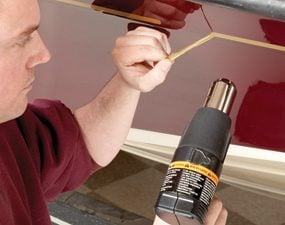
Photo 1: Remove old numbers and pinstripes to begin fiberglass repair
Set the heat gun to a low setting and peel off the old decals and numbers. Use adhesive remover to get rid of any residue.
No boat spiff-up is complete without new license numbers, transom names and pinstripes. Just do an online search for "boat graphics" and you'll find thousands of options to choose from. Find stripes by searching for "boat pinstripes." Remove the old ones by warming them with a heat gun (Photo 1). But be careful—if you overheat the surface, you can burn the gel coat. If yours are painted on, sand them off with 1200-grit sandpaper.
Fix gouges: Prep

Photo 2: Prepare deep gouges
Cut a U-shaped groove into the gouge with a high-speed die grinder or rotary tool and a burr nose bit. Taper the edges of the gouge to eliminate sharp edges in the old gel coat.
Grind out gouged areas with a V-shaped grinder bit (Champion SF1; from heavydutystore.com; Photo 2). Sand out the light scratches, starting with 80-grit, to 150-grit, and ending with 240-grit.
Fix gouges: Fill and smooth

Photo 3: Prepare the filler
Stir in enough chop to get the mixture to the consistency of peanut butter. Then add hardener (follow the manufacturer's ratio) and stir, stir, stir.

Photo 4: Fill in the gouge
Scoop the gel coat putty into the gouge. Then press it into the fibers with a craft stick. Add more putty until you're about 1/32 in. above the surface. Clean up any goofs with acetone.

Photo 5: Sand the patch
Knock down the excess putty with 80-grit sandpaper and a rubber sanding block. Then switch to 240-grit.
To fix gouges and deep scratches, you'll need "chop" (powdered fiberglass) filler, gel coat and gel coat reducer. Jot down your boat's model and serial numbers and contact the manufacturer to order gel coat (about $100 per qt.) to match your boat's color. It may not be an exact match, but it'll be a lot closer than mixing colors from scratch. Then order some gel coat reducer (Patch-Aid is one brand; about $49 per qt. from minicraft.com or spectrumcolor.com) to thin the mixture enough to go through the spray gun. For gouge repair, you'll mix chop filler (Chris uses Cab-O-Sil from epoxy5050.com) with the gel coat to create a thick paste. Then pick up paper cups, stir sticks, acetone (for cleanup) and rags. You'll also need a disposable spray gun (Preval is one brand; about $7 online or at paint and art supply stores). To finish the job, you'll need a professional-type buffer. The variable-speed feature is important, and so is the high power of a professional buffer. So don't skimp on one or think you can get by with a $29 wax polisher. Use a wool buffing pad (such as a Dewalt DW4988 pad, available through our affiliation with amazon.com or westmarine.com), and buffing compound (3M Imperial Compound and Finishing Material, which is what Chris uses, available through our affiliation with amazon.com or westmarine.com).
Mixing gel coat is a messy and stinky process—so wear chemical-resistant gloves, safety goggles and a respirator. Start with a small amount of gel coat and stir in the chop and hardener to make a putty that's the consistency of peanut butter (Photo 3). Once you add the hardener, you've only got a 10- to 20-minute "open" time, so mix small batches and work on one gouge at a time. Thorough mixing is critical to proper curing. Spend a full minute stirring. If you don't, you'll end up with patches of sticky resin that can take days to harden.
Overfill gouges so the filler mounds slightly. You'll sand it flush after it cures. Curing can take one to two hours—depending on humidity levels. So test it by touch. If it's sticky, it's not fully cured. Once it's fully hardened, sand it with 80-grit sandpaper (Photo 5).
Color-Matching Gel Coats
Sometimes you can't get your hands on factory gel coat (your boat is too old or the manufacturer is out of business). Then you have two options. You can order an off-the-shelf color that's close to yours and decide that "close enough is good enough." The other option is to custom mix, but be aware that this is no easy task. Buy a color chip chart for off-the-shelf colors (from a local marine supplier, or get the No. 01900 color chart from rayplex.com for about $12). Mix your own color with a kit (No. 33114; about $35) from rayplex.com.
Fix gouges: Apply the finish
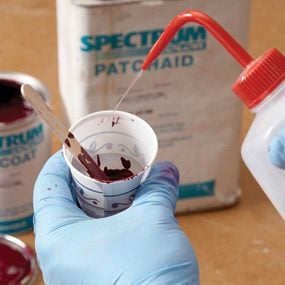
Photo 6: Mix new gel coat
Add the hardener after you've mixed in the reducer. Follow the manufacturer's recommended ratio of hardener to gel coat.
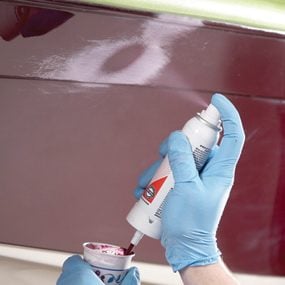
Photo 7: Spray on the final coat
Pulse the sprayer to get short bursts of gel coat. Feather the spray along the edges to reduce sanding.
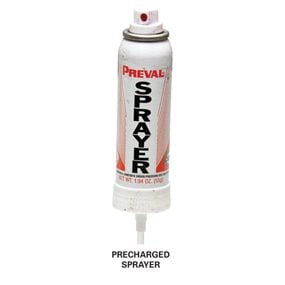
Photo 7A: Close-up of sprayer
A pre-charged sprayer applies the final coat more smoothly than brushing, but you still have to sand it out.
Now you're ready to mix a fresh batch of gel coat (without the chop) and spray the scratched and patched areas (Photos 6 and 7). Chris recommends using a disposable spray gun and paper cups. Unthinned gel coat won't go through the sprayer. Add the recommended amount of reducer (read label directions) and hardener and mix the ingredients. Spray the patched areas with short bursts. Spraying gel coat isn't like spraying paint. It splatters on and has to be sanded and buffed to get to a smooth gloss. So don't be disappointed that the finish isn't paint-like right away during your fiberglass boat repair.
Final-sand, buff and wax
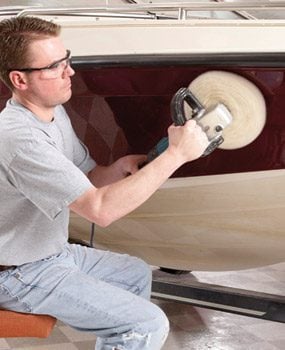
Photo 8: Buff to a great shine
Take a seat and heft the buffer into position. Start slowly and buff small sections at a time.
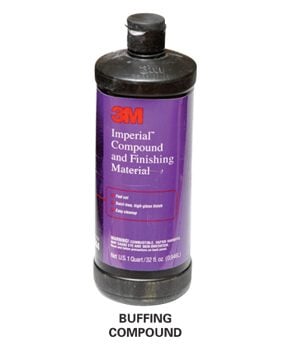
Photo 8A: Close-up of buffing compound
Buffing compound produces a silky smooth finish.
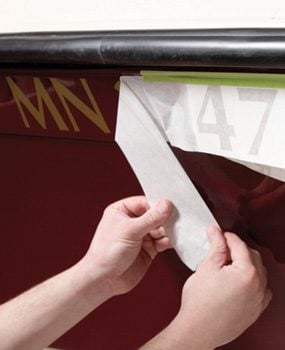
Photo 9: Apply new decals
Position the new boat numbers and tape the sheet in place. Then lift the sheet up, remove the backer and press each number individually. Don't try to apply them all at once—they'll wrinkle.
Wait for the gel coat to cure. Sand the repairs with 600-grit and then 800-grit sandpaper. For the perfect finish, sand with 1,200-grit wet/ dry paper then buff (Photo 8). Apply buffing compound directly to the pad. Work on a 2 x 2-ft. area and use light to medium pressure at a fairly low speed. Reduce pressure as the compound starts to dry. Wipe off the haze as you go. Apply the graphics and then wax.
Order of Events for Fiberglass Boat Repair
Wash and rinse the boat. That will show you all the dings that need fixing. Mark them with masking tape so you won't forget any.
If you're replacing pinstripes, license decals or other graphics, remove them next.
Fill any deep gouges and spend your time sanding out scratches while the filler sets up.
Apply gel coat to the filled gouges and finish to the scratches and then final-sand the filled gouges.
Buff all the repaired areas and then the rest of the boat.
Apply any graphics to finish up.
Required Tools for this Boat Fiberglass Repair Project
Have the necessary tools for this DIY boat fiberglass repair project lined up before you start—you'll save time and frustration.
You'll also need a variable speed buffer, wool buffing pad, chemical-resistant gloves, respirator and a burr-nose grinder bit.
Required Materials for this Boat Fiberglass Repair Project
Avoid last-minute shopping trips by having all your materials ready ahead of time. Here's a list.
Similar Projects
How To Repair Fiberglass Boat Hull
Source: https://www.familyhandyman.com/project/how-to-repair-fiberglass/
Posted by: baisdenbefer1961.blogspot.com

0 Response to "How To Repair Fiberglass Boat Hull"
Post a Comment